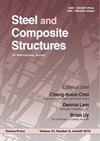An approach for partial strengthening of circular RC columns using outer steel tube
IF 3.9
3区 工程技术
Q1 CONSTRUCTION & BUILDING TECHNOLOGY
引用次数: 0
Abstract
This paper introduces an improved design equation to evaluate the resisting capacity of circular reinforced concrete (RC) columns partially strengthened with outer steel tube. When RC column members are required to be strengthened according to the change in the loadings considered and/or the deterioration progress in columns, wrapping up RC column with steel circular tube, which takes the form of concrete filled steel tube (CFST), has been popularly considered because of its structural advantage induced from the confinement effect. However, the relatively high construction cost of steel tube is restricting its use to the required region, while deriving the shape of a partial CFST column. To evaluate the resisting capacity of a partial CFST column, numerical analyses need to be performed, and a numerical model proposed in the previous study for the numerical analysis of full CFST columns is used to conduct parametric studies for the introduction of a design equation. The bond-slip effect developed along the interface between the in-filled concrete and the exterior steel tube is taken into consideration and the validity of the numerical model has been established through correlation studies between experimental data and numerical results for partial CFST circular columns. Moreover, parametric studies make it possible to introduce a design equation for determining the optimum length of outer steel tube which produces partial CFST circular columns.钢筋混凝土圆形柱外筒局部加固方法研究
本文介绍了一种改进的外钢管部分加固圆形钢筋混凝土柱抗压能力评估设计方程。当钢筋混凝土柱构件需要根据所考虑荷载的变化和/或柱的劣化进度进行加固时,钢管混凝土(CFST)形式的钢圆管包裹钢筋混凝土柱由于其约束效应所带来的结构优势而被广泛考虑。然而,相对较高的施工成本限制了钢管的使用范围,同时推导了部分钢管混凝土柱的形状。为了评估部分CFST柱的抗压能力,需要进行数值分析,采用前人研究中提出的全CFST柱数值分析的数值模型进行参数化研究,引入设计方程。通过对部分钢管混凝土圆柱的试验数据与数值结果的相关性研究,考虑了沿混凝土与外钢管界面方向发展的粘结滑移效应,验证了数值模型的有效性。此外,参数化研究使得引入设计方程来确定产生部分CFST圆柱的最佳外钢管长度成为可能。
本文章由计算机程序翻译,如有差异,请以英文原文为准。
求助全文
约1分钟内获得全文
求助全文
来源期刊

Steel and Composite Structures
工程技术-材料科学:复合
CiteScore
8.50
自引率
19.60%
发文量
0
审稿时长
7.5 months
期刊介绍:
Steel & Composite Structures, An International Journal, provides and excellent publication channel which reports the up-to-date research developments in the steel structures and steel-concrete composite structures, and FRP plated structures from the international steel community. The research results reported in this journal address all the aspects of theoretical and experimental research, including Buckling/Stability, Fatigue/Fracture, Fire Performance, Connections, Frames/Bridges, Plates/Shells, Composite Structural Components, Hybrid Structures, Fabrication/Maintenance, Design Codes, Dynamics/Vibrations, Nonferrous Metal Structures, Non-metalic plates, Analytical Methods.
The Journal specially wishes to bridge the gap between the theoretical developments and practical applications for the benefits of both academic researchers and practicing engineers. In this light, contributions from the practicing engineers are especially welcome.
 求助内容:
求助内容: 应助结果提醒方式:
应助结果提醒方式:


